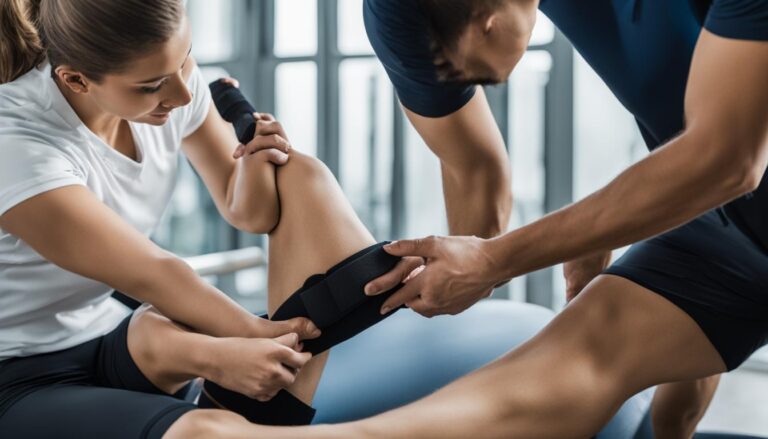Dealing with Sharp Knee Pain When Straightening Your Leg
Sharp knee pain when straightening your leg can be quite troubling. It can make everyday activities difficult and uncomfortable. This article will help you understand what might be causing this pain, how it can be diagnosed, and the different treatment options available. You’ll also learn about ways to prevent it and how to live with chronic knee pain if it doesn’t go away.
Key Takeaways
- Sharp knee pain can have many causes, from injuries to medical conditions.
- Seeing a doctor is important if the pain is severe or doesn’t go away.
- There are many treatments, including rest, exercises, and sometimes surgery.
- Preventing knee pain involves strengthening exercises and wearing proper shoes.
- Living with chronic knee pain requires good pain management and support.
Understanding Sharp Knee Pain When Straightening Your Leg
Common Symptoms
Sharp knee pain when straightening your leg can be very uncomfortable. Common symptoms include a sudden, intense pain that might feel like a stabbing sensation. You may also notice swelling, redness, or warmth around the knee. Sometimes, the knee might feel weak or unstable, making it hard to stand or walk.
Possible Causes
There are several reasons why you might experience sharp knee pain. Injuries like ligament tears or meniscus tears are common culprits. Conditions such as arthritis or tendinitis can also cause this type of pain. Overuse from activities like running or jumping can lead to pain as well. It’s important to identify the cause to get the right treatment.
When to Seek Medical Attention
If your knee pain is severe or doesn’t go away, it’s time to see a doctor. You should also seek help if you can’t put weight on your leg or if your knee looks deformed. Early treatment can prevent further damage and help you get back to your normal activities faster.
Ignoring knee pain can lead to more serious problems down the road. It’s always better to get it checked out sooner rather than later.
Diagnosing the Cause of Sharp Knee Pain
Medical History and Physical Examination
When you visit a doctor for sharp knee pain, they will start by asking about your medical history and any past injuries. They will also perform a physical exam to check for swelling, tenderness, and range of motion. This helps them understand the root cause of your pain.
Imaging Tests
Doctors often use imaging tests like X-rays, MRIs, or CT scans to get a clear picture of your knee. These tests can show if there are any issues with the bones, cartilage, or ligaments. Imaging tests are crucial for a proper diagnosis.
Differential Diagnosis
Sometimes, doctors need to rule out other conditions that might be causing your knee pain. They will compare your symptoms with other possible issues to make sure they find the right cause. This process is called differential diagnosis.
Getting the right diagnosis is key to finding the best treatment for your knee pain.
Non-Surgical Treatments for Sharp Knee Pain

Rest and Activity Modification
One of the first steps in managing sharp knee pain is to rest and change your activities. Avoid movements that make the pain worse. Sometimes, just taking a break can help your knee heal.
Physical Therapy
Physical therapy can be very helpful. A therapist will show you exercises to make your knee stronger and more flexible. This can reduce pain and help you move better.
Medications and Injections
Over-the-counter pain relievers like ibuprofen can help with knee pain. In some cases, doctors might suggest injections to reduce swelling and pain. These treatments can be very effective for many people.
Taking care of your knee early can prevent more serious problems later. If you feel sharp pain, don’t ignore it. Rest and see a doctor if needed.
Surgical Options for Persistent Knee Pain
Arthroscopy
Arthroscopy is a minimally invasive surgery where a small camera is inserted into the knee joint. This allows the surgeon to see inside the knee and fix any problems. This procedure is often used to repair torn cartilage or remove loose fragments. Recovery time is usually shorter compared to other surgeries.
Knee Replacement Surgery
Knee replacement surgery involves removing damaged parts of the knee and replacing them with artificial components. This surgery is typically recommended for severe arthritis or significant injury. Patients often experience a significant reduction in pain and improved mobility after recovery.
Recovery and Rehabilitation
After surgery, recovery and rehabilitation are crucial. Patients will need to follow a structured physical therapy program to regain strength and mobility. It’s important to follow the doctor’s advice closely to ensure the best outcome.
For those dealing with persistent knee pain, surgical options can provide much-needed relief and improve quality of life.
Preventing Sharp Knee Pain When Straightening Your Leg
Strengthening Exercises
Regular exercises can help keep your knees strong and flexible. Focus on workouts that target the muscles around your knee, like squats and leg lifts. Strong muscles support your knee better and reduce pain.
Proper Footwear
Wearing the right shoes can make a big difference. Choose shoes that offer good support and cushioning. Avoid high heels and worn-out shoes, as they can strain your knees.
Lifestyle Modifications
Making small changes in your daily routine can help prevent knee pain. Maintain a healthy weight to reduce stress on your knees. Also, avoid activities that put too much pressure on your knees, like jumping or running on hard surfaces.
Taking care of your knees now can save you from a lot of pain later. Simple steps can make a big difference in your knee health.
Living with Chronic Knee Pain
Pain Management Strategies
Living with chronic knee pain can be challenging, but there are ways to manage it. Pain management strategies include using over-the-counter pain relievers, applying ice or heat, and practicing relaxation techniques. It’s important to find what works best for you.
Support and Resources
Finding support and resources is crucial. The Johns Hopkins Medicine website offers medical services, research, and pediatric care. They provide valuable information and updates, such as new dean appointments and COVID-19 guidelines in Maryland. Support groups and online forums can also be helpful.
Maintaining Mobility and Quality of Life
Maintaining mobility and quality of life is essential. Regular exercise, like walking or swimming, can help keep your knee flexible and strong. Using assistive devices, such as a cane or knee brace, can also make daily activities easier. Remember to listen to your body and rest when needed.
Conclusion
Dealing with sharp knee pain when straightening your leg can be tough, but it’s important to listen to your body and take action. Whether it’s through rest, exercises, or seeing a doctor, there are ways to manage and reduce the pain. Remember, taking care of your knees now can help you stay active and healthy in the future. Don’t ignore the pain; address it early to prevent more serious problems later on. Stay proactive and keep your knees in good shape!
Frequently Asked Questions
What causes sharp knee pain when I straighten my leg?
Sharp knee pain when straightening your leg can be caused by various issues like ligament injuries, meniscus tears, or arthritis. It’s best to see a doctor to find out the exact cause.
How can I relieve sharp knee pain at home?
You can try resting your knee, applying ice, and taking over-the-counter pain relievers like ibuprofen. Gentle stretching and strengthening exercises might also help.
When should I see a doctor for knee pain?
You should see a doctor if your knee pain is severe, lasts more than a few days, or if you have symptoms like swelling, redness, or an inability to put weight on your leg.
What treatments are available for knee pain without surgery?
Non-surgical treatments include rest, physical therapy, medications, and injections. Your doctor can help you decide which option is best for you.
Are there exercises to prevent knee pain?
Yes, exercises that strengthen the muscles around your knee can help prevent pain. Squats, leg raises, and hamstring stretches are good examples.
Is knee pain a sign of something serious?
Sometimes, knee pain can be a sign of a serious condition like a torn ligament or arthritis. It’s important to get it checked out to know for sure.







